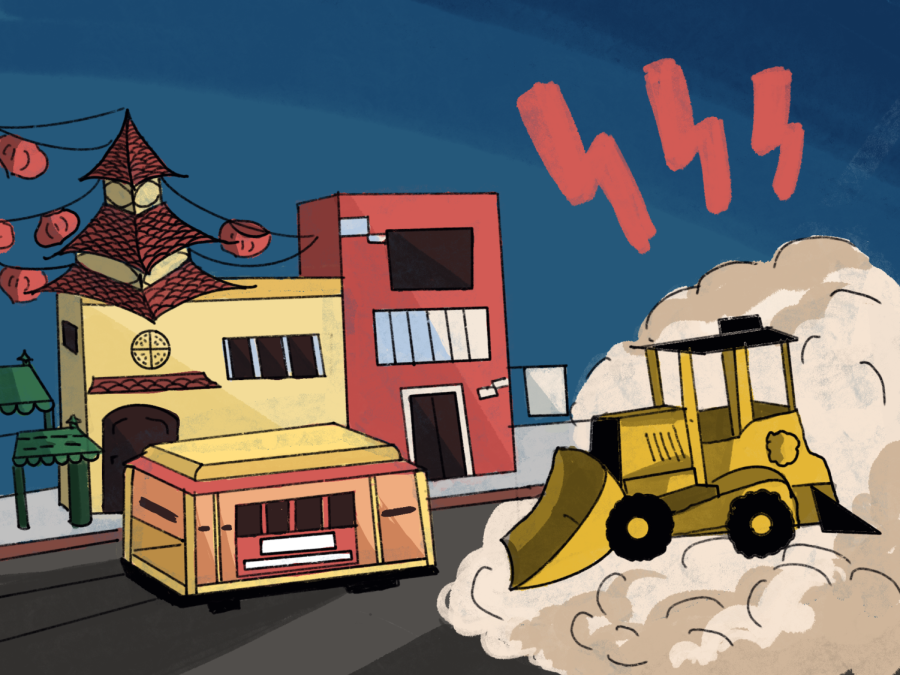OPINION: There is no replacement for Chinatown
Unfavorable developments, like the proposed 76 Place at Market East in Philadelphia, represents a growing threat to the livelihood of Chinatowns across America.
By 2031, 76 Place at Market East is a proposed arena expected to be the future home of the National Basketball Association’s Philadelphia 76ers. The location of the arena, however, is located one block away from Philadelphia’s Chinatown. This proposal is an oncoming danger to the livelihood of Chinatowns across the United States, who are subject to continued racial discrimination, loss of cultural significance, gentrification and displacement.
Chinatown – while known for its dim sum restaurants, bakeries and tea shops – is also a symbol of a neighborhood defined by its people and a history of resilience, acceptance and rejection. According to the National Archives and Records Administration, in 1882, the Chinese Exclusion Act was passed to prevent the immigration of Chinese people to the U.S. Additionally, already present Chinese people in America were denied the right to citizenship. A long history of combating bigotry includes the Chinese Massacre of 1871 in Los Angeles, California located in the city’s Chinatown.
A racist and repressive history that lurks behind Chinatowns demonstrates a multilayered story of resilience against an unwelcoming America. Despite angry mobs of non-Chinese laborers burning multiple Chinatowns down, the success and survival of Chinatown is found in its communities who represent intergenerational stories that are important to preserve. Chinese laborers were the backbone of cities, contributing through their grocery stores, laundromats, restaurants and other small businesses for immigrants experiencing discrimination and seeking a home away from home. While xenophobic sentiments against Asian Americans heightened in recent years due to wrongly associating the COVID-19 pandemic to the Asian American Pacific Islander community, the younger generations and community advocates have worked together to rise above the negative narratives and protect Chinatown’s defining history.
As popular tourist locations, Chinatowns represent design and architecture that expands culture to the public. According to the Washington District of Columbia Office of Planning, the Chinatown Design Review Procedures require projects and renovations in Chinatown districts to include Chinese architectural elements and motifs that express information about Chinese culture. Aspects include Chinese characters on signage and various colors and material found in traditional Chinese architecture, such as ceramic tile and glazed terra cotta.
The artistic components help solidify the identity of Chinatowns, opening up the community and visitors to experience the culture. The unique design and layout of the Chinatown districts allow for a growing tourist attraction that brings support for local small businesses and restaurants. The loss of a Chinatown would be detrimental to Chinese families – many of whom are immigrants – who find a supportive home in the district and are surrounded and comforted by a sense of familiarity.
Commercial and residential developments create encroaching gentrification and displacement for Chinatown’s residents. According to a University of California, Berkeley case study of the San Francisco Bay Area’s Chinatown, inhabitants face significant pressures as rental costs and mortgage prices have skyrocketed since 2000. With increasing desirability of San Francisco’s real estate and a competing need for affordable housing for low-income residents of Chinatown, the survival of the city is at stake of change and residential displacement.
Similarly, harmful projects and developments like the proposed 76 Place at Market East set precedent for other companies and businesses to follow in their footsteps. This, in turn, drives up the cost of housing and drives out Chinatown’s residents, who will likely struggle to find affordable housing elsewhere. With the consideration of factors like poverty and unemployment, the more residents forced out of Chinatown will weaken the community’s connections and values. The vibrancy and livelihood of the city must live on for future generations.
In order to curtail changes to Chinatowns across the nation, taking initiative is necessary to preserve communities and foster equitable development. The W.O.W. Project in Manhattan’s Chinatown, for example, is helping save Chinatown and protect the community from gentrification. The W.O.W Project is a community-based initiative taking action through the arts to create projects that include artist residencies, youth programs and public artwork and events to connect the history of Chinatown with its future.
In addition, according to research from University of California, Los Angeles’s Asian American Studies Center, the lack of English fluency among the large immigrant population can impact access to and the quality of services. In 2020, the Delta Chinatown initiative was formed to combat anti-Asian hate crimes, raise funds for surveillance cameras and create a victims’ awareness group to help senior citizens and others know their legal rights. This initiative is especially significant for addressing social inequality within the AAPI community.
Lastly, protection from developmental pressures and advances preserve historic properties like Chinatowns. With areas at risk of unfavorable development, it is important to get involved in one’s local community and fight against proposals that put Chinatowns at danger. There is no replacement for a home like Chinatown.


